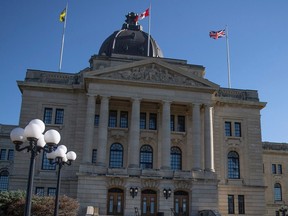Were an election held today, 49 per cent of decided survey respondents said they would cast a ballot in favour of the NDP while 47 said they would vote for the Sask. Party

This election year in Saskatchewan could bring a close race, according to a recent poll showing vote intention swaying in favour of the NDP.
Were an election held today, 49 per cent of decided survey respondents said they would cast a ballot in favour of the NDP while 47 said they would vote for the Sask. Party, according to an Insightrix poll released Friday.
A general election is set to be held on or before Oct. 28.
The poll result is a considerable swing from polling done in April 2023, which showed the Sask. Party was favoured by 46 per cent of respondents, while the provincial NDP were preferred by 37 per cent.
The last time the NDP polled ahead of the Sask. Party appears to be June of 2017, when 49 per cent of respondents to a Mainstreet Research poll commissioned by Postmedia the previous month said they supported then interim party Leader Trent Wotherspoon and the NDP, while 40 per cent said they supported then premier Brad Wall and the Sask. Party.
Carla Beck, leader of the Opposition, said she’s not going to count her chickens before they hatch, and while it’s encouraging, she said there’s work to be done.
“The only poll that matters is election day and we’re not taking anything for granted,” said Beck.
“Our team plans to continue to work hard every single day to earn the trust and support of the people of Saskatchewan.”
The Sask. Party doesn’t appear concerned about the new numbers.
“Insightrix polls have been historically quite inaccurate,” said Patrick Bundrock, executive director of the Saskatchewan Party, in an emailed statement.
“For example, in their last poll taken during the 2020 provincial election campaign, Insightrix underestimated the Saskatchewan Party’s support by seven points (double the stated margin of error),” said Bundrock.
“So we are doubtful that these poll results are accurate.”
Leading up to the 2020 general election, Insightrix published a poll in which 54 per cent of respondents indicated they would cast their ballot for the Sask. Party while 35 per cent planned to vote for the NDP.
The actual figures from that election saw the incumbents take home 60.67 per cent of the ballots cast while the NDP received 31.59 per cent.
The cities have increasingly swung to the NDP, with Saskatoon appearing to show the strongest support for the opposition party compared to anywhere else in the province. The north and south of the province, rural areas in particular, remain strongholds for the Sask. Party.
Modelling done by a contributor to 338Canada, based on the polling, showed the Sask. Party winning 31 seats — 29 from rural constituencies and 2 from Saskatoon — and the NDP taking 30 — 12 seats in Regina and Saskatoon and 6 from rural Saskatchewan. That’s a net change of 17 more for the NDP and 17 fewer for the Sask. Party.
Teacher negotiations and bargaining with the Saskatchewan Teachers’ Federation (STF) proved to be a divisive topic among Sask. Party supporters. According to the poll, public opinion is largely on the side of the teachers with 68 per cent of respondents backing the STF.
Among Sask. Party supporters, 37 per cent support the government, 36 per cent support the teachers and 27 per cent are undecided.
Heading into two days of bargaining this coming week, STF president Samantha Becotte said these figures show the public support she and teachers have seen around the province.
“We hope that the provincial government takes note and comes to the table ready to bargain on class size and complexity to ensure that we can meet the needs of students across the province,” she said in a written response.
Among NDP supporters, 95 per cent of poll respondents support the teachers, three per cent are undecided and two per cent support the government.
Undecided voters also overwhelmingly favour the teachers, with 77 per cent siding with them, 17 per cent unsure and six per cent supporting the government.
According to the poll’s margin for error, the research was conducted online, and “is considered to be a non-probability proportion sample; therefore, margins of error are not applicable. However, the margin of error can be estimated to be ±3.5 percentage points, 19 times out of 20 for questions answered by all respondents.”
Eight hundred people responded to the poll, according to Insightrix.